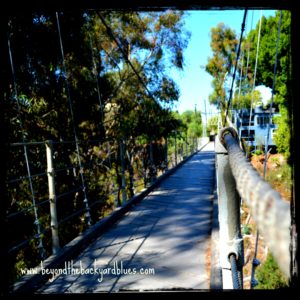 There is something magical about a bridge, the way it connects two areas, it’s as if it beckons for all who pass over to explore life on either side.
There is something magical about a bridge, the way it connects two areas, it’s as if it beckons for all who pass over to explore life on either side.
On Wednesday my friend Ruth and I met in San Diego, then set out to discover two of the cities “secret” bridges, the Spruce Street Suspension Bridge and the Quince Street Bridge.
My love for bridges is no doubt tied to the long root that was my New England upbringing. Steeped in summer trips where we headed north from our Connecticut home to visit my cousin, he lived just at the edge of the shadow cast from the White Mountains, in a small Northern New Hampshire town.
Once there, my mother let me drive, the fragrance from fresh cut hay swirled from the rolled down windows and a symphony of cricket-song blended with the tick of the car engine when the tires on dirt crackled to a stop. I remember stepping into the heat so we could walk the distance of the covered bridge in the town of Bath. Its length stretched above the Ammonoosuc River, supported by enormous rock abutments, all made from hand hewn wood. Even today I can picture the spire from a church rising up above it, feel the cool from its shade and hear the floor boards rumble beneath the weight of a passing car.
In early September Ruth attached an article onto my Facebook page titled, Secret San Diego, which featured a photo of the Spruce Street Suspension Bridge, after seeing it, I could hardly wait to go.
Our day began with the Spruce Street bridge, built in 1912, the structure was designed by San Diego’s own, Edwin Capps. Raised in Tennessee, Capps came to San Diego via Golden, Colorado, in 1886. First hired as the City Engineer, he later went on to serve two terms as Mayor. The “wiggly bridge,” as it is affectionately called, is the only one of it’s kind in the county.
The bridge is beautiful. Suspended from two steel cables anchored to concrete piers at either end, the wood footpath is 375 long. It stretches 70 feet above the, Arroya Canyon, a canyon better known for the city-famous woman horticulturist, Kate Sessions. Apparently Kate was responsible for planting many of the different species of plants we could see below, from the tall Eucalyptus trees to the vibrant blue plumbago shrubs, truly it was a feast for the eyes.
I was reminded how much I enjoy experiencing something new with a friend. Ruth is the mastermind behind, Cranium Crunches, an online resource for brain health. Among the plethora of resource choices she provides on her websitesite are games. I listened as Ruth described the steps she requires of herself to create her, “One Of These Things Is Not Like The Other,” game. Later I was lucky enough to witness her in action. Her trained eye focused on different aspects of the things that surrounded us and with a click of the camera she captured what she wanted. I look forward to seeing the game come to life when she adds it to her blog.
Hanging from the braided cables of the bridge were numerous padlocks. Locks of all types and sizes–we speculated over their 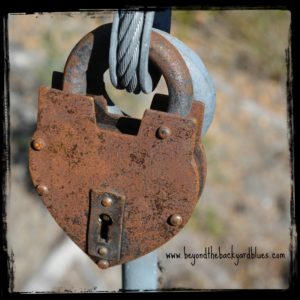 meaning–and somewhere in the deep cavity of my mind I remembered reading about “love-locks” attached to a famous Paris bridge. We stooped to inspect them, sure enough proclamations of love were scribbled on the backs of many.
meaning–and somewhere in the deep cavity of my mind I remembered reading about “love-locks” attached to a famous Paris bridge. We stooped to inspect them, sure enough proclamations of love were scribbled on the backs of many.
As legend has it, the tradition dates back to WWI…
The story goes that a school teacher, Nada, fell in love with a Serbian officer, Relja. During their courtship the two lovers would meet at a local bridge–The Bridge of Love–before Relja headed off to war, the couple became engaged. Sadly, while in Greece, the officer falls in love with another woman and breaks his promise to marry. It is said that Nada never recovers and later dies from heartbreak. As news of Nada’s story spread, local girls, eager to avoid the same fate, inscribed their name along with their true-loves, on the backs of padlocks, then hung them from the Bridge of Love. The popularity of the tradition resurfaced in the early 2000’s.
I find it heartwarming, the idea of professed love locked up without a key, all those padlocks remind us that love–even if but temporary–gives us hope for the future.
After we were finished there we walked south to the Quince Street bridge, an even older jewel lodged in the crown, we in San Diego know as, Bankers Hill.
Ruth and I took in the massive trestle structure first from Fourth Avenue. Built in 1902, the bridge appears more wild west than urban California. Sixty feet above Maple Canyon the bridge spans 236 feet. Once on it, the first thing we happened upon was a graffiti tag that read, “Don’t believe the hype.” Again we wondered aloud over meaning. Ruth offered that she’d seen a mural of some kind with the same message.
I learned today that the origin of the message dates back to 2010, artists Gustavo and Otavio Pandolfo, who go by Osgemeos, or twins in Portuguese, were brought to San Diego by the Museum of Contemporary Art, during which time they painted an enormous permanent mural as part of the “Viva la Revolución” exhibit.
Built to connect two neighborhoods and make the trolley accessible, the Quince Street Bridge is no stranger to controversy. Now earmarked as an historical landmark, I learned this morning that it owes its right to remain to the fierce fight put up by a woman named Elinor Meadows. Elinor once lived in the enormous house that graces the edge of Maple Canyon. Of course I couldn’t help but love her given we share the same name (that’s right, a little known secret, my real name is Elinor…) but it’s more than that. From what I read about her, she embodied the spirit of community, she was an activist and an individual who stood up firm in her boots when the foundation she knew was threatened.
We crossed over the foot bridge and found the trail which took us to the base of Maple Canyon. Once down there, it was fun to see the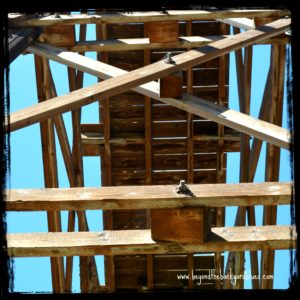 bridge from underneath, particularly given the contrast provided from the backdrop, a cloudless blue sky. We ambled down the dirt path until it reached a neighborhood, houses whose backyard includes a beautiful canyon to explore.
bridge from underneath, particularly given the contrast provided from the backdrop, a cloudless blue sky. We ambled down the dirt path until it reached a neighborhood, houses whose backyard includes a beautiful canyon to explore.
Ruth and I then headed to Balboa Park. There we enjoyed our bagged lunches followed by a walk that took us over the the Cabrillo Bridge. We finished the day wandering through the spectacular Botanical Garden and the Inez Grant Parker Rose Garden.
We are so fortunate to live in a city rich with beauty–all free–to the willing explorer. As Ruth and I parted ways I was reminded of my commitment to live beyond the backyard blues…
Living Beyond the Backyard Blues means stepping beyond the boundaries of your backyard home. It is about finding the extraordinary in the ordinary. It is the voice inside you that beckons you to explore, to live, to be.
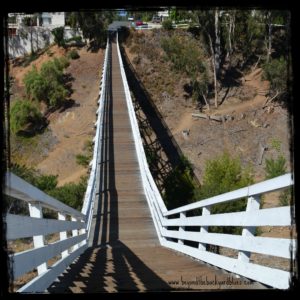
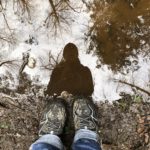

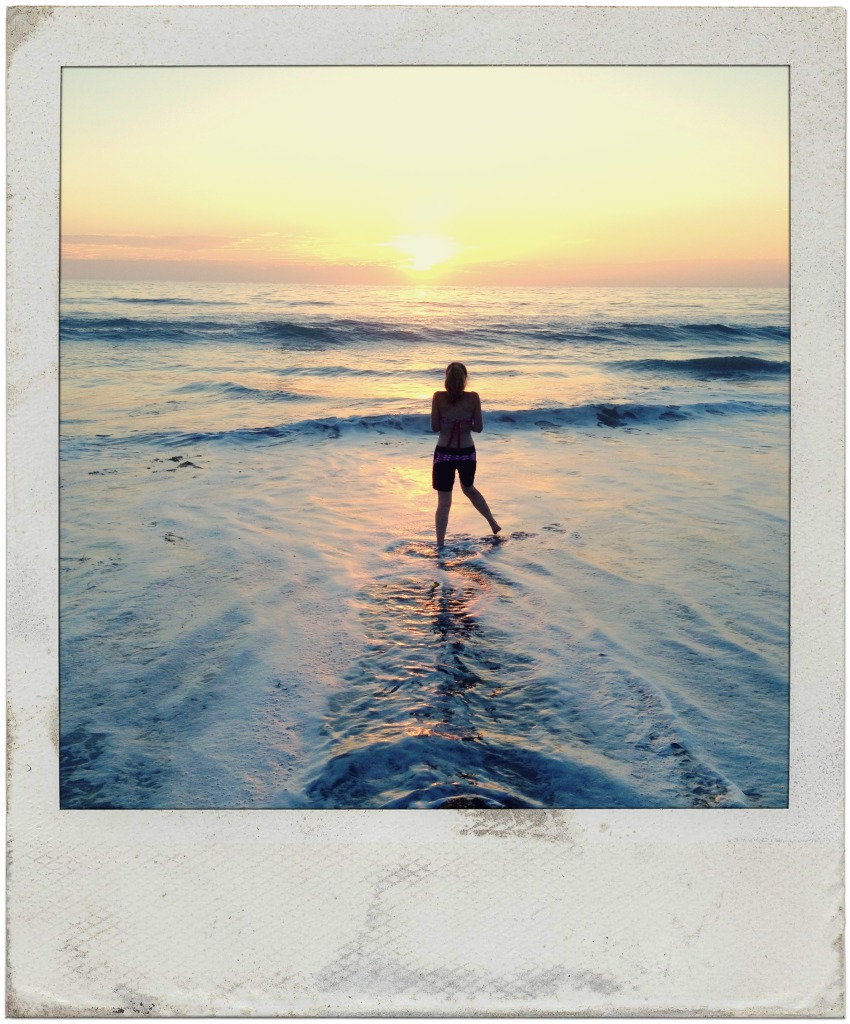
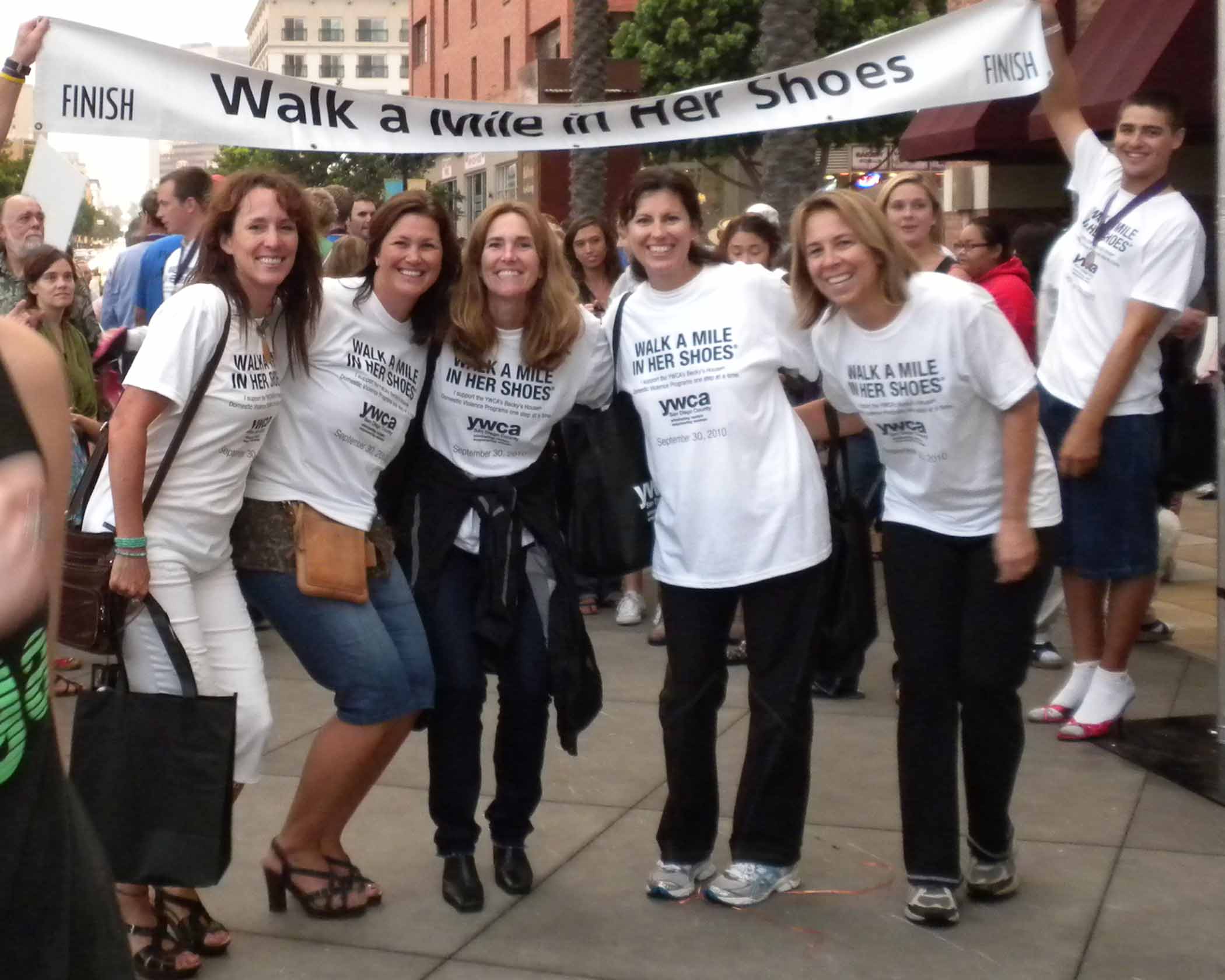
That Ruth Curran, she is EVERYWHERE! You two must’ve had a blast!
Ha! Yes she is. And we did. 🙂
Love finding these local gems. And bridges. 🙂
Thanks for stopping by Penny, yes, the local gems are the best.
This is super. I felt like I was right there alongside you and Ruth. Fantastic background on the bridges, the stories. Thank you for sharing!
Thanks Lisa! One of these days maybe you will come to SD and we can create an adventure for all of us to experience. 🙂
So cool but, ahem, where was I on that trip?! I have a padlock inscribed with Michael and my names that I got in Niagara Falls, which I’ve been waiting to use on our next trip to Paris. We might have to just lock it here instead so we can visit it more regularly!
You were cavorting with Edee! Haha! Love the idea that you could visit your lock here…so many bridges…which one to choose?
What a great day, perfectly told. There is nothing like a walking, talking, and sharing perspective!
And…I love that your perspective on the locks was right on the money! Thank you for including me in your quest to find the extraordinary in the ordinary! So much fun, soul cleansing, and gratifying! Next?
It was so much fun. The list is long…I rather fancy the idea of visiting that restaurant with the hidden staircase. 😉
In!
My love for bridges came from my father who was an engineer. Many of our vacation centered around bridges. Thank you for reminding me of these special memories.
Thank you for visiting today and sharing too.
Wonderful post. I like bridges, too. I once lived in Pittsburgh and entering into Pittsburgh I cane through a tunnel onto a bridge where you could see the entire city. It was splendid abd took my breath away every.single.time. 🙂
Oh I love your description, makes me want to see that first hand!
I love the story about the love locks. Bridges fascinate me, too. Good reading.
Thanks for stopping by today and for your nice comment too.
This piece made me want to run away from home and visit San Diego! You SD ladies know how to have fun. I used to be terrified of bridges. In high school my “friends” would stop on the middle of them and watch me freak out while they laughed their asses off. I got over that fear. I should start collecting visits to bridges…
Do it! We would welcome you with open arms Nancy! Glad you got over your fear and I look forward to hearing about the bridges you discover.
I love that the two of you did this, absolutely extraordinary.
We have a few covered and/or wooden bridges here in Pennsylvania. Sadly they are disappearing. It is so important to fight for and restore them.
Personally bridges, tunnels and heights terrify me but I do push myself …
That second one looked very high:)
I completely agree Doreen. I have never understood the tendency toward destruction, we should fight to keep them. I’m a little bit height phobic too…like you, I push myself, especially since I just broke up with fear ;-). Having a camera helps. It took my attention from the height and placed it on zeroing in on the beauty of the structures.